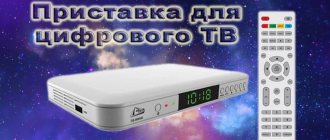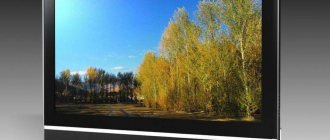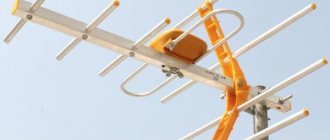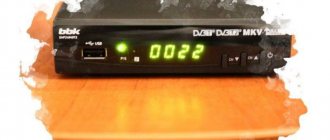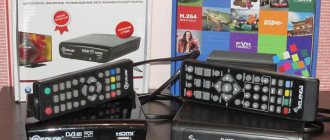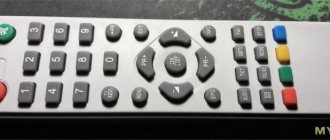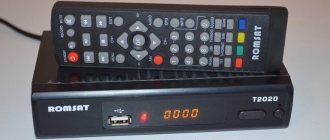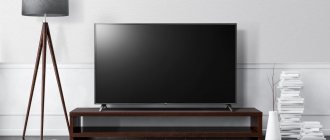| Place | Name | Characteristics in the rating |
| The best indoor antennas with amplifier |
| 1 | Thomson ANT1425 | Best amplifier |
| 2 | Hyundai H-TAI220 | High build quality. Ease of setup |
| 3 | Selenga 105A | The optimal choice for signal reception in any conditions |
| 4 | REMO BAS-5310 Horizon USB | The most attractive price |
| 5 | Perfeo Forward | The amplifier does not require a network connection |
| The best indoor antennas for a summer residence |
| 1 | Delta K131A.03 | Optimal ratio of reception quality and price |
| 2 | REMO BAS-5324-USB Diagram | Buyer's Best Choice |
| 3 | LUMAX DA1502A | Universal model |
| 4 | Delta K331A.02 | High-quality data transfer |
| 5 | Antenna DENN DAA238 | Reliable reception of a remote signal. Elegant design |
| The best indoor antennas for receiving a digital signal |
| 1 | REMO BAS-5107-5V Mini Digital | No need for an external adapter |
| 2 | Antenna BBK DA03 | Favorable price offer. Satisfactory build quality |
| 3 | Delta Digit.5V | The best choice for working with a digital set-top box |
| 4 | Locus L 942.10 CAYMAN | Steel body. For a reliable reception area |
| 5 | GAL AR-007 | The best combination of price and performance |
DVB-T2 or an antenna for receiving a digital signal for watching TV will be the focus of our attention. To this day, the best antenna is the one on the roof of your house, but technology has moved far forward, making it possible to install signal receivers indoors. The best choice for a country house or cottage would be a satellite dish or a giant antenna with many receiving elements.
In general, the antennas we are considering are designed primarily to receive signals from decimeter waves, that is, from 400 to 800 MHz. They were sold before, but their setup and design were associated with imperfect technology and a number of installation problems. Modern communication quality has lowered the requirements for receiving elements. We have selected for you the top 10 best indoor antennas for connecting and watching quality TV.
Reasons for signal deterioration
What should you do and what not to do in order to receive a more or less high-quality digital signal and not degrade it?
First, do what you need to do to get the best possible antenna signal. A high-quality, narrowly directional antenna for a TV in the countryside is placed further and higher from large metal objects. It is advisable that there are no very high obstacles on the imaginary line from the antenna to the television transmitter: hills, waste heaps, tall trees. Install your antenna away from the iron roof of your country house, and in no case - under the iron roof itself, then there is guaranteed to be no digital television reception.
To avoid degrading the received signal, lay the cable correctly:
- don't use the cable you bought when your grandfather went to first grade;
- Don't buy the cheapest cable with virtually no braid. Choose normal cables;
- Do not shorten the cable as much as possible;
- do not make sharp bends in the cable;
- Do not twist the excess cable into a coil.
Even if you connect pieces of cable with a standard coaxial connector, the signal quality is guaranteed to deteriorate.
You can see how to strip the cable here.
The best antennas for digital TV
The most popular indoor devices for digital TV, according to buyers.
Antenna REMO BAS-5340-USB TVJET
Technical specifications:
- Type: with amplifier;
- Reception: DVB-T/DVB-T2;
- Operating range: VHF/UHF;
- VHF Gain: 23 dB;
- UHF signal: 43dB;
- Resistance: 75 Ohm;
- Manufacturer: Kursk, Russia
- Power: USB;
- Weight: 0.4 kg;
Indoor television device with a new integrated amplification system. The device itself is made of modern and high-tech materials. The body of the device is so durable and safe to use that you can safely hang it on a bracket or place it on a windowsill. The antenna catches signals: in office buildings, in residential complexes, at high altitudes. An indicator on the USB cable warns that the device is working correctly. The REMO television device provides reliable power supply and stable image transmission quality. Average cost: 510 rubles.
Antenna REMO BAS-5340-USB TVJET
Advantages:
- Compact size;
- Durable housing;
- Low price.
Flaws:
- Short cable included.
Antenna Delta K131A.03
Characteristics:
- Placement: indoor unit;
- DVB-T/DVB-T2: yes;
- Operating range: UHF
- Gain: 40 dB;
- Weight: 0.8 kg;
- Power: USB;
- Manufacturer: Russia;
A good device that picks up channels consistently. The big advantage of the model is that you can adjust the signal gain. This function allows you to catch channels where simple devices cannot cope with this task. The antenna is perfect for use both in the city and in the country. The device provides reception of twenty channels in excellent quality. The body of the device is made of metal. Cost of the device: 950 rubles.
Antenna Delta K131A.03
Advantages:
- A light weight;
- Small size;
- Signal adjustment function.
Flaws:
- Metal body;
- High price;
- Flimsy stand;
- Too light, you can easily lose the orientation.
Antenna Locus L 941.10 CAYMAN
Device parameters:
- Type: room with amplifier;
- UHF Gain: 12dB;
- Operating frequency range: 472-853 MHz;
- Cable length included: 1.2 m;
- Manufacturer: Moscow;
- Warranty period: 12 months;
- Power supply not included;
- Weight: 0.3 kg.
The device is an active type and provides reception of digital and UHF channels at a distance of up to 12 km. from the tower. This device has a large number of positive reviews among customers. Compared to other similar devices, Cayman has strong range properties, which allows it to receive a more uniform signal. The entire structure is made of steel. The device comes with a low-noise integrated amplifier, which is powered by a 5 W TV. The kit includes a 2 meter long coaxial cable. Average cost of Cayman: 650 rubles.
Antenna Locus L 941.10 CAYMAN
Advantages:
- Compactness;
- Ease of setup;
- Ease;
- Good channel reception;
- Low cost.
Flaws:
- Not identified.
Antenna HARPER ADVB-2120
Technical specifications:
- Device type: room with amplifier;
- VHF/UHF operating ranges: yes;
- DVB-T/DVB-T2: yes;
- Power: from antenna cable;
- Cord length: 1.3 meters;
- Warranty period: 12 months.
The device picks up the signal perfectly, even at a considerable distance from the tower (from 10-30 km). In addition to the standard 20 channels in digital quality, the device picks up decimeter channels. Easy to install, compact in size and easy to customize for any user. You just need to connect the device to the TV and start the search. If, as a result of the search, no channels are found, then it is necessary to move the antenna mechanically towards the tower. Cost of the device: 950 rubles.
Antenna HARPER ADVB-2120
Advantages:
- Catch many channels in good quality;
- Small size;
- Easy setup;
- Confident and stable reception.
Flaws:
- Unstable stand.
Antenna REMO BAS-5310 Horizon USB
Options:
- DVB-T/DVB-T2 reception: yes;
- Power source: USB;
- Wire length: 1.3 meters;
- Supply voltage: 5 V;
- Black color;
- Manufacturer: Saratov, Russia;
- Device weight: 0.3 kg.
A compact device, active type, which will allow it to catch a larger number of channels in excellent quality. It receives television channels in the frequency range from 175-860 MHz. Gain is supplied via USB cable. The device is located in a flat housing made of radiotransparent polymer. The device provides stable reception of channels. The antenna is powered via a coaxial cable from the receiver or TV if it has this function. The mount that this model has makes it possible to place it both on a plane and to mount the device on the wall. Average cost: 700 rubles.
Antenna REMO BAS-5310 Horizon USB
Advantages:
- Compact;
- Picks up the signal well;
- The design has several mounting options.
Flaws:
- Short USB cable.
Antenna GoDigital AV 1007
Technical specifications:
- Amplifier: none;
- VHF/UHF: yes;
- Manufacturer: Russia;
- Power: 220W;
- Gain: 3-5 dB;
- DVB-T/DVB-T2: yes;
- Warranty period: 1 year.
Compact passive antenna. The device is capable of receiving and catching channels in DVB-T2 format. Compatible with any TV models. To make the signal cleaner and higher quality, you must manually adjust the direction of the device. For more efficient operation, it is recommended to install the device no more than 15 km from the transmitter. Device price: 250 rubles.
Antenna GoDigital AV 1007
Advantages:
- Low price;
- Excellent reception quality;
- Compact;
- High quality and stable construction.
Flaws:
- Not detected.
Antenna Delta Digital.5V
Specifications:
- Device type: room active;
- Reception of digital channels: yes;
- UHF signal: yes;
- Gain: 23 dB;
- Characteristic impedance: 75 Ohm;
- Cable length: 3.5 m;
- Frequency range: UHF 470-791 (61-81 channels).
The indoor device is designed to receive digital television channels through a set-top box. An amplifier is integrated into the device, which allows you to increase the signal level. The antenna itself does not have a power supply; the source is designed to supply voltage from a digital set-top box. Delta digital 5V consumes 5 watts. If it is not possible to install the device as close as possible to the tower, you can receive the reflected signal. The device is quite easy to configure and install with your own hands. This model is perfect for use both within the city and in suburban areas. Device price: 650 rubles.
Antenna Delta Digital.5V
Advantages:
- Compact design;
- Excellent signal reception;
- Provides 20 digital channels when installed correctly.
Flaws:
- Flimsy packaging, you need to be careful when transporting.
Theory and calculations
The described antenna, in theory, has a horizontal “figure-of-eight” radiation pattern and a relatively high gain, which can be further increased by using a reflector/reflector.
To obtain maximum gain on all channels, it is necessary to make an antenna approximately in the middle of the range between the multiplexes used.
Finding (for calculations) the frequencies of multiplexes used in your region is easy,
for example, a request like “dvb-t2 channel frequencies” + “Krasnodar”
I found something like this:
The middle, between “my” two multiplexes, is 700 MHz - we will calculate the antenna at this frequency.
As a basis for calculating the dimensions of the antenna, we take the drawing of its author
Calculate the wavelength: λ = 300 / f [m]
300/700 = 0.428m, approximately 43cm length of each side of the rhombus
λ/4
=43/4= 10.75
The total length of the material we need (11cm*8=88cm) is less than a meter. The distance between the reduction contacts, where we will solder the cable, is 10-12mm (the standard value for this antenna for frequencies below 900 MHz).
I will make a simple antenna, without a reflector, however, to further increase the gain of this antenna, it is quite possible to install it behind it
for example, from a metal mesh/grill, foil material or simply a metal plate. Its dimensions should be approximately 20 percent larger than the dimensions of the antenna and it should be located at a distance of ƛmax/7. For my case: wavelength (channel 39) 300/618, it turns out...49/7= that is, about 7cm
For those who are too lazy to do the calculations themselves
— you can use an online calculator, the results will differ only slightly from those I received. Here, for example, this one - here you immediately enter the frequencies of two multiplexes and get the dimensions of the antenna (without a reflector) Or another option, with a reflector - I really want to note that in the second option a slightly different calculation option is used, different from the author’s. An antenna with angles other than 90° is assumed and the reflector distance is calculated as λ/8
To make the antenna sheet, it is recommended to use aluminum or copper (copper is easily soldered) with a diameter of 3 mm and higher - the larger the diameter, the more broadband the antenna is. You can use tubes; the thickness of the walls is not important, since only the surface of the material is used (in fact, you can wrap any dielectric with foil to obtain the required material). However, in my opinion, the easiest way is to buy a meter of large-gauge copper wire at an electrical supply store.
What you need to know about the amplifier
When you decide to buy or equip your TV antenna for your dacha with an amplifier, you must take into account several features of its use. Here they are:
- he needs food;
- it can burn out during a severe thunderstorm, especially if there is no good grounding and lightning protection;
- The power supply to the amplifier may not be of very good quality over time, this will ruin your signal;
- The amplifier can amplify some interfering strong signal, and thereby degrade the useful antenna signal.
A frequently asked question: what kind of incomprehensible power is this for the antenna amplifier, or for the antenna? Where should I stick it? So, the antenna itself does not require any power. But, if the antenna signal is weak, and you additionally use an amplifier, then it really needs power. You buy a special power supply along with the amplifier.
If the amplifier can operate from a 5 Volt power supply, then you can supply power to it from the tuner itself; this power is of high quality and has no ripple. But most antenna amplifiers operate on 12 Volt power.
Satellite
Remember? We're talking about T2 terrestrial digital television, so forget about satellites. You will not receive terrestrial television in the DVB-T2 standard through a satellite tuner. You will not connect the T2 tuner to a satellite dish. We receive the T2 signal from the nearest broadcast tower in the UHF range. To a regular over-the-air antenna for a summer residence, not a “dish”.
Reliability
Speaking about reliability, it must be said that this is an industrially manufactured antenna. It should be well secured to the mast and the cable leading to it should not dangle in the wind. If the amplifier is not installed on the antenna itself, then firmly attach it to some fixed support. Seal the box with the amplifier well from moisture or fill it with silicone. Do all this only after the final setup.
If the antenna with the simulator is placed above the roof, and the amplifier is placed below, under the roof, then this provides additional ease of maintenance, because periodically you need to look into the amplifier, clean the connections, and remove cobwebs from the box.
A little history
In the early 60s of the last century, our compatriot Kharchenko K.P. developed a simple flat zigzag antenna with good characteristics.
Copyright certificate No. 138277 for an invention called “Band directional antenna” was issued to Konstantin Pavlovich Kharchenko in 1961 (according to his application dated June 16, 1960). In the same year, materials were published in the magazine “Radio” for repetition by radio amateurs.
The antenna is not critical to materials and dimensions during manufacturing, has a simple good match with the reduction cable, and it successfully combines multiple elements of a common-mode antenna array with a single feed point.

